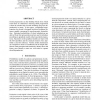Free Online Productivity Tools
i2Speak
i2Symbol
i2OCR
iTex2Img
iWeb2Print
iWeb2Shot
i2Type
iPdf2Split
iPdf2Merge
i2Bopomofo
i2Arabic
i2Style
i2Image
i2PDF
iLatex2Rtf
Sci2ools
ISMIR
2005
Springer
2005
Springer
A Probabilistic Model for Chord Progressions
Chord progressions are the building blocks from which tonal music is constructed. Inferring chord progressions is thus an essential step towards modeling long term dependencies in music. In this paper, a distributed representation for chords is designed such that Euclidean distances roughly correspond to psychoacoustic dissimilarities. Estimated probabilities of chord substitutions are derived from this representation and are used to introduce smoothing in graphical models observing chord progressions. Parameters in the graphical models are learnt with the EM algorithm and the classical Junction Tree algorithm is used for inference. Various model architectures are compared in terms of conditional out-of-sample likelihood. Both perceptual and statistical evidence show that binary trees related to meter are well suited to capture chord dependencies.
Chord Progressions | Graphical Models | Information Retrieval | ISMIR 2005 | Models Observing Chord |
Related Content
| Added | 27 Jun 2010 |
| Updated | 27 Jun 2010 |
| Type | Conference |
| Year | 2005 |
| Where | ISMIR |
| Authors | Jean-François Paiement, Douglas Eck, Samy Bengio |
Comments (0)

